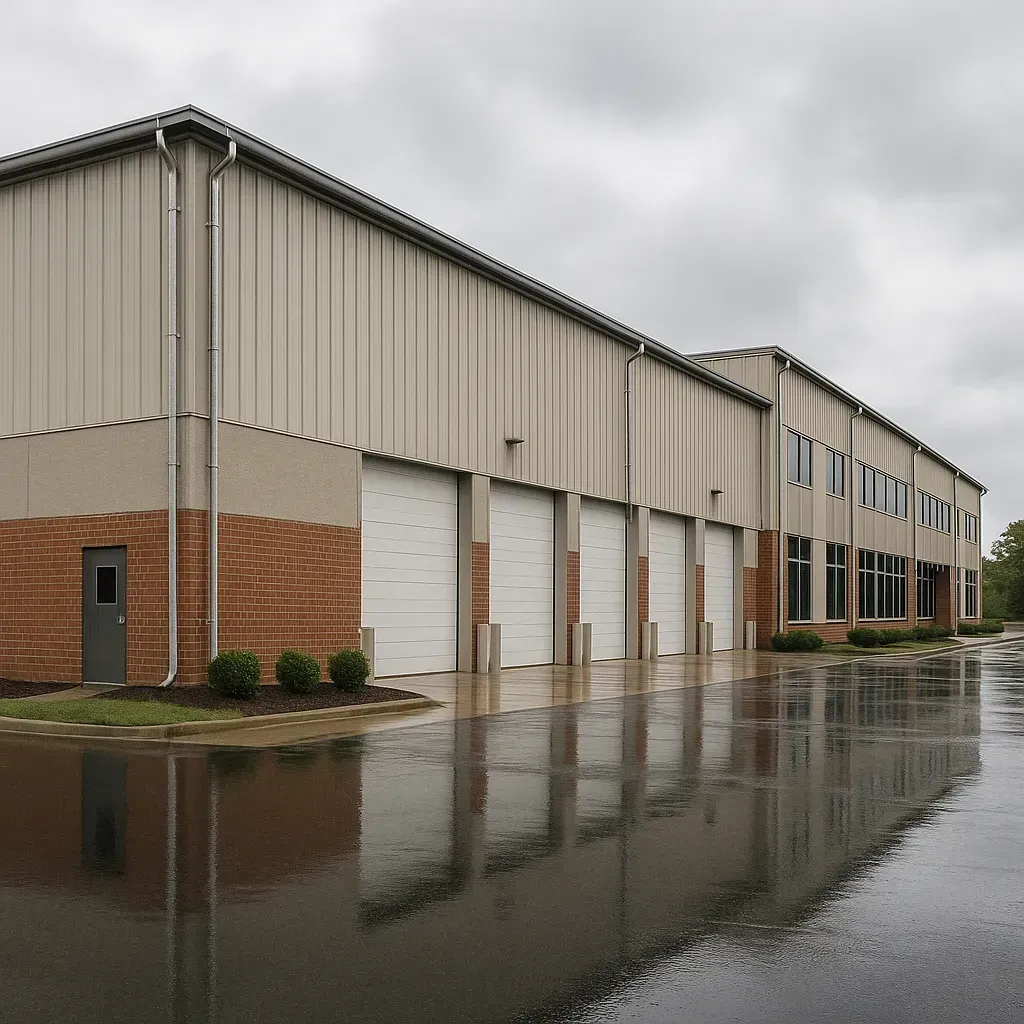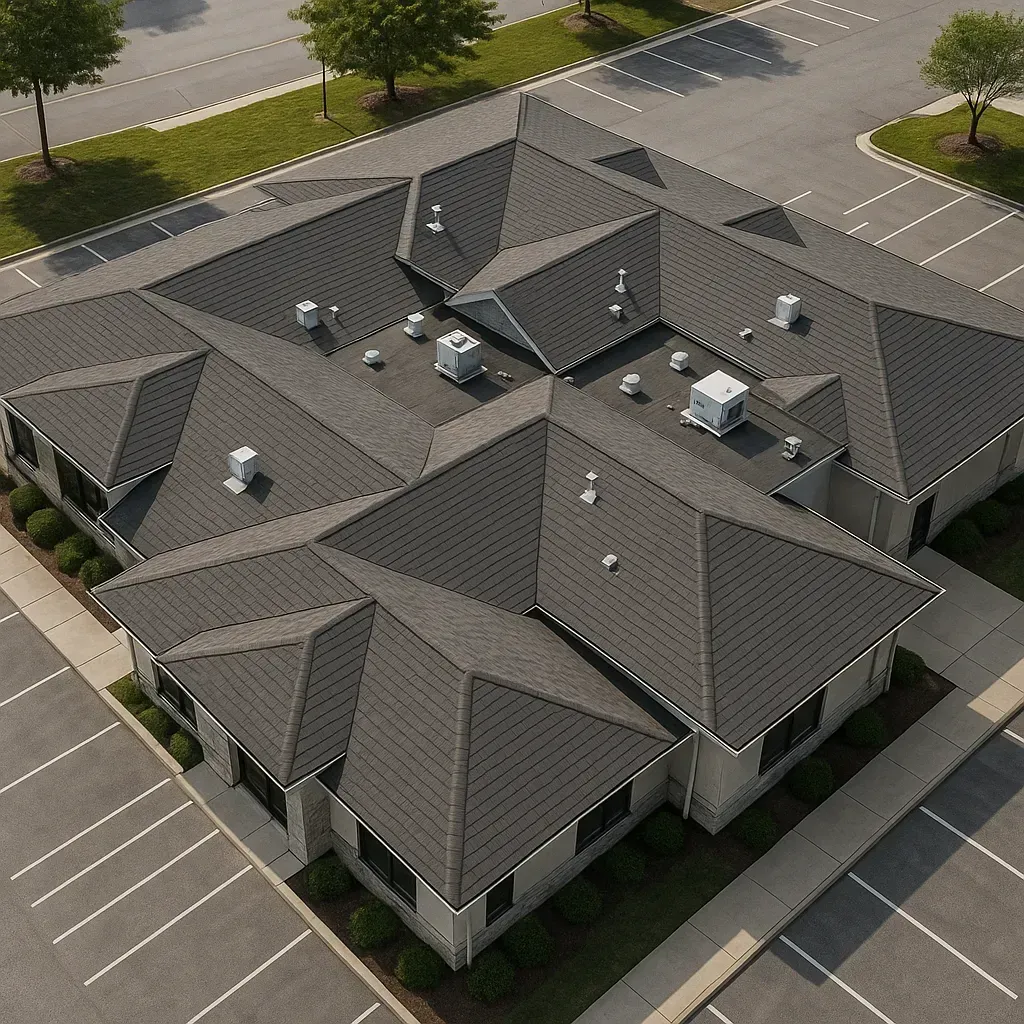Choosing the Right Commercial Gutter Size for Your Building
Picking the right commercial gutter size for your Wichita business is one of the most important choices you'll make. The wrong size can cause big problems like water damage, foundation issues, and costly repairs. Business gutter solutions need to be much bigger than home gutters because commercial buildings have larger roofs.
Commercial building gutter systems face higher risks than home gutters. When gutters fail on a warehouse, office, or store, it can hurt your business in many ways. Water damage can shut down operations, create safety risks for workers and customers, and lead to expensive insurance claims. In Wichita, where spring storms bring heavy rain and winter weather creates drainage problems, getting the right commercial gutter sizes is even more important.
Industrial gutter products must handle much more water than home gutters. Commercial buildings have big roofs, and Wichita gets about 30 inches of rain each year. During bad storms, we can get 2-4 inches of rain in just one hour. This means your commercial rainfall drainage system needs to move a lot of water quickly. Many business buildings also have complex roof designs that make water flow in different ways.
This guide will help you learn what affects commercial gutter sizing. We'll cover how to figure out what your building needs and how Wichita's weather impacts your choices. Whether you're building new, fixing up an old building, or dealing with water problems, choosing the right gutter size now can save you thousands later.
[If you're looking into gutters for your business, see our commercial gutter services in Wichita]

Commercial Gutter Sizing: What You Need to Know
Commercial-grade gutters work very differently than home gutters. Business gutter installation needs much bigger gutters because commercial buildings have huge roofs that collect way more water. High capacity commercial gutters are measured by how many gallons per minute they can handle.
Your Size Options
Most commercial gutter contractors offer these choices:
5-inch gutters
These move about 1,200 gallons per minute. They only work for very small office buildings or shops with roofs under 2,000 square feet. These will overflow during Wichita's heavy spring storms.
6-inch gutters
6 inch handle 2,000 gallons per minute and are the most popular choice for business gutter protection. They work well for most retail stores, small warehouses, and office buildings with roofs up to 8,000 square feet. Most gutter materials for businesses come in 6-inch sizes.
7-inch and 8-inch gutters
These are heavy-duty options for big buildings. Steel gutters industrial applications often use these sizes for large warehouses, factories, and shopping centers. They cost more but prevent expensive water damage.
Custom oversized gutters
Custom are bigger than 8 inches work for huge buildings like aircraft hangars and large manufacturing plants. These special commercial box gutters are made to order and cost much more.
Style Matters Too
Most businesses choose K-style gutters because they hold about 25% more water than half-round gutters of the same size. However, half-round gutters look more traditional on historic buildings.
Downspouts Are Key
Your downspouts matter too. A 6-inch gutter usually needs one downspout for every 40 feet of gutter. Industrial rainwater systems might need downspouts every 30 feet. Without enough downspouts, even big gutters will overflow during storms.
[Need help choosing which size? We can help with our commercial gutter services!]
Factors That Determine Proper Gutter Size
Picking the right commercial roof gutter size depends on several important things. Getting these factors right helps make sure your business gutter solutions work when you need them most.
Roof Area and Slope
The bigger your roof, the bigger gutters you need. A flat 10,000 square foot roof collects way more water than a steep 5,000 square foot roof. Flat roofs are tricky because water moves slowly toward the gutters. Steep roofs send water rushing down fast, which can overwhelm small gutters during heavy rain.
To figure out your roof area, measure the length and width of each roof section. Don't forget to include any additions or different levels. Each section needs its own calculation for the best commercial building drainage.
Wichita's Weather Patterns
Wichita gets about 30 inches of rain each year, but it doesn't come evenly. Spring storms can dump 3-4 inches in one hour. Summer thunderstorms often bring 1-2 inches very quickly. Your gutter service for businesses needs to handle these peak times, not just average rainfall.
The worst storms happen in April, May, and June. During these months, aluminum commercial gutter systems get tested the most. If your gutters can't handle a 2-inch-per-hour storm, you'll have problems.
Building Height and Wind
Tall buildings face stronger winds that can push rain sideways into gutters. Wind also makes rain hit your roof harder and faster. A 3-story building needs bigger gutters than a 1-story building of the same roof size.
Roof Materials
Different roof materials handle water differently. Metal roofs shed water very fast, so they need bigger gutters. Flat rubber roofs hold water longer, giving gutters more time to drain. Tile roofs can channel water in specific directions.
Building Design
Some buildings have architectural features that affect water flow. Decorative elements, multiple roof levels, and building shape all matter. Seamless commercial gutters work better on complex buildings because they have fewer places where leaks can start.

Common Sizing Mistakes to Avoid
Many business owners make costly mistakes when choosing gutters. Learning what to avoid can save you thousands of dollars and prevent major headaches.
The Undersizing Problem
The biggest mistake is picking gutters that are too small. When gutters can't handle heavy rain, water overflows and damages your building. This creates several serious problems:
- Water runs down walls and damages siding, windows, and doors
- Foundation problems from water pooling around your building
- Parking lots and walkways flood, creating safety risks for customers
- Insurance claims and liability issues if someone gets hurt
- Expensive gutter repair business calls during busy seasons
Small gutters also clog easier. When leaves and debris block a 5-inch gutter, it overflows fast. A 6-inch gutter has more room for debris and keeps working during storms.
The Oversizing Trap
Some people think bigger is always better, but oversized gutters have problems too. Very large gutters cost much more to buy and install. They also look bad on smaller buildings and can make your business look industrial when you want it to look professional.
Huge gutters also need more downspouts, which costs more money. If you don't really need 8-inch gutters, you're wasting money that could go toward other business needs.
Ignoring Local Weather
Many businesses use gutter sizes that work in other places but not in Wichita. Our spring storms are different from steady rain in other areas. Commercial gutter cleaning becomes much harder after storms if your gutters can't handle the water flow.
Skipping Professional Help
The biggest mistake is trying to figure out gutter sizes yourself. Professional commercial gutter contractors know local building codes, weather patterns, and installation requirements. They can spot problems you might miss and help you avoid expensive fixes later.
[There's a lot of problems you can run into with your commercial gutters. Check out our guide for Common Commercial Gutter Problems in Wichita]
Maintenance Considerations by Gutter Size
Different gutter sizes need different amounts of care. Understanding this helps you plan for ongoing costs and keeps your gutters working right.
Cleaning Frequency
Smaller gutters fill up with leaves and debris faster than big ones. Five-inch gutters might need company gutter cleaning every 3-4 months. Six-inch gutters can often go 6 months between cleanings. Larger 7-inch and 8-inch gutters sometimes only need cleaning twice per year.
However, bigger gutters collect more debris overall. When an 8-inch gutter gets clogged, it takes longer to clean than a small gutter. The good news is that large gutters keep working even with some debris inside.
Cost Differences
Gutter maintenance businesses charge more to clean bigger gutters because they take more time and effort. Cleaning 5-inch gutters might cost $2-3 per linear foot. Seven-inch or 8-inch gutters can cost $4-5 per linear foot to clean.
Custom oversized gutters cost even more to maintain. Special equipment might be needed, and fewer companies offer this service. Plan for higher ongoing costs with very large gutter systems.
Accessibility Challenges
Bigger gutters are often on taller buildings, making them harder to reach safely. This limits your options for gutter cleaning services and increases costs. Some gutter maintenance businesses won't work on gutters over 20 feet high without special equipment.
Plan for these ongoing costs when choosing your gutter size. Sometimes spending more upfront on the right size saves money on maintenance over time.
Get the Right Gutters for Your Wichita Business
Choosing the right commercial gutter systems for your building is too important to guess at. The wrong size can lead to expensive water damage, safety problems, and costly repairs that hurt your business. From small office buildings to large warehouses, every commercial property in Wichita needs gutters that can handle our unpredictable weather.
Remember the key factors: your roof size and slope, Wichita's heavy spring storms, your building height, and roof materials. Most businesses do best with 6-inch gutters, but larger buildings need 7-inch or 8-inch systems. Don't forget that proper downspout spacing is just as important as gutter size.
Avoid the common mistakes of undersizing your gutters or trying to figure this out alone. Professional gutter installation commercial services understand local building codes, weather patterns, and long-term maintenance needs. They can help you choose the right size and materials that will protect your investment for years to come.
Ready to protect your Wichita business with the right commercial building drainage system? Contact our experienced team for a free consultation and estimate. Don't wait for the next big storm to find out your gutters are too small, call us today ((316) 350-7115) and get the peace of mind that comes with properly sized commercial gutters. Learn more about our commercial gutter services
